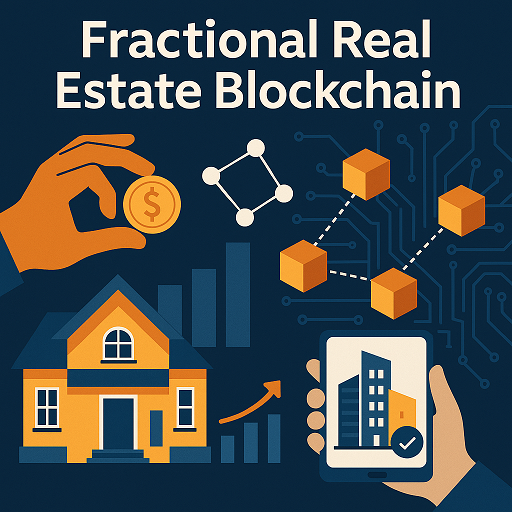Fractional real estate blockchain is revolutionizing how people access property investment, offering a fresh and more inclusive approach to real estate ownership.
Historically, investing in real estate meant needing large amounts of capital, specialized industry knowledge, and often, a bit of luck to find the right opportunity. Whether it’s buying a rental home or acquiring a commercial unit, the barriers to entry were high for the average investor. But the advent of blockchain technology, particularly in the fractionalization of assets, is breaking down these barriers and changing the game. In this article, we’ll explore how fractional real estate blockchain is reshaping the property market, who benefits, and what lies ahead for this transformative trend.
How Tokenization Powers Fractional Real Estate Blockchain
Tokenization serves as the backbone of fractional real estate blockchain, allowing real-world properties to be digitally broken down into smaller, tradable pieces of ownership. These tokenized shares can be bought and sold on blockchain platforms, opening real estate investment to a much broader and more diverse group of participants.
By enabling a property to be divided into digital fractions, tokenization empowers developers and owners to reach investors who previously lacked the capital or access. It transforms an illiquid asset class into one that can be traded like stocks or cryptocurrencies, reshaping how people think about real estate investing.
Why Fractional Real Estate Blockchain Matters
There are several reasons why this innovation is gaining traction:
- Lower Barriers to Entry: Investors can now enter the real estate market with as little as $100, making it accessible to millennials, students, and anyone who historically felt priced out.
- Global Reach: Through blockchain, people in one country can invest in real estate in another, bypassing currency exchange issues and regulatory hurdles.
- Liquidity: One of real estate’s biggest drawbacks is its illiquidity. But with tokenization, owners can sell their fractions on digital exchanges, enabling faster exits.
With these benefits, fractional real estate blockchain introduces a more agile, modern way of thinking about investment and asset ownership.
Platforms Leading the Fractional Real Estate Blockchain Revolution
Several platforms are paving the way in this domain:
- RealT: One of the early movers, allowing users to invest in U.S. real estate via Ethereum-based tokens.
- Brickblock: Focused on connecting asset managers with investors via blockchain infrastructure.
- Propy: Strives to streamline every step of the real estate transaction—from registering titles to processing payments—using blockchain and automation.
Each platform has its nuances, but all of them use blockchain technology to create verifiable, secure, and efficient marketplaces for fractional property ownership.
Legal and Regulatory Considerations for Fractional Real Estate Blockchain
Among the most significant challenges for fractional real estate blockchain initiatives is navigating complex legal frameworks. Real estate regulation varies from country to country—and often from region to region—making it essential for blockchain projects to ensure compliance.
Regulatory bodies such as the U.S. SEC and Europe’s ESMA are increasingly focusing on how real estate tokenization intersects with financial laws. Their involvement highlights the need for transparency and regulatory alignment in the rapidly growing digital property investment sector.
While regulation introduces complexity, it also builds investor confidence by establishing clear legal protections and accountability.
The Role of Smart Contracts in Fractional Real Estate Blockchain
Smart contracts—automated protocols deployed on blockchain networks—are central to streamlining operations in fractional real estate blockchain ecosystems. These digital agreements:
- Automatically manage the distribution of rental income
- Instantly validate and authenticate ownership rights
- Monitor legal compliance across jurisdictions
- Govern resale activity, enabling token holders to sell their property shares under clearly defined and automated rules
These programmable contracts minimize the need for middlemen and make the system more efficient. With enhanced reliability and fewer manual steps, smart contracts pave the way for seamless property investment experiences.
Use Cases: Who Benefits from Fractional Real Estate Blockchain?
The adoption of fractional real estate blockchain provides meaningful advantages to a wide spectrum of participants:
- Individual Investors: Those with limited capital can now access real estate portfolios once reserved for the wealthy.
- Institutional Stakeholders: Asset managers gain improved liquidity and a new investment channel.
- Property Developers: Builders and landlords can access a global pool of investors without relying solely on traditional financing models.
- Remote and International Buyers: Digital platforms allow cross-border transactions with fewer obstacles and faster settlements.
As these groups engage with tokenized property markets, the real estate landscape is becoming more flexible and equitable.
Challenges and Risks in Blockchain-Based Real Estate Models
Despite the excitement around it, the road ahead for fractional real estate blockchain is not without hurdles:
- Market Volatility: Property tokens may experience value fluctuations influenced by real estate fundamentals as well as broader cryptocurrency sentiment.
- Liquidity Constraints: Although improved, liquidity may still be limited compared to traditional securities markets.
- Evolving Regulations: Jurisdictional laws can change, potentially disrupting operations or access.
- Digital Security: Blockchain systems must remain protected against cyberattacks and technical vulnerabilities.
Investors should carefully assess risk, choose trustworthy platforms, and remain aware of the rapidly changing legal environment.
Traditional Real Estate vs. Blockchain-Based Investment
The contrast between conventional property investment and blockchain-based fractional models highlights just how transformative this technology can be:
| Comparison Point | Traditional Real Estate | Blockchain-Based Fractional Real Estate |
|---|---|---|
| Entry Capital | Requires significant upfront funds | Affordable entry through fractional ownership |
| Liquidity | Difficult and time-consuming to sell | Enhanced liquidity via token marketplaces |
| Geographic Flexibility | Often restricted by local access | Open to global investors across borders |
| Transaction Speed | Typically takes weeks | Fast execution, often within minutes or hours |
| Transparency | Limited visibility into processes | Complete traceability enabled by blockchain |
| Administrative Burden | Heavy paperwork and intermediaries | Automated workflows through smart contracts |
This side-by-side view underscores how fractional real estate blockchain modernizes investment by improving access, efficiency, and transparency for a wider range of participants.
How Real Estate Funds Are Reacting to the Fractional Real Estate Blockchain Model
Traditional real estate funds are taking notice. Many are exploring partnerships or launching blockchain-based pilot programs. For instance:
- Some REITs (Real Estate Investment Trusts) are now exploring tokenized shares.
- Private equity firms are investing in blockchain infrastructure providers.
- Major banks are experimenting with real estate tokenization in sandbox environments.
Rather than viewing it as a threat, many established players see fractional real estate blockchain as a complementary evolution that opens new business models.
The Future of Real Estate Investment: Powered by Blockchain
Looking ahead, several trends will likely define the next wave of innovation:
- Integration with the Metaverse: Virtual properties may become tokenized assets too.
- Cross-chain Solutions: Interoperability will allow assets to be traded across different blockchain networks.
- AI-powered Portfolio Management: Artificial intelligence will help investors choose properties and time their investments better.
- Increased Retail Participation: As awareness grows, more people will join the decentralized investment movement.
The blending of blockchain, real estate, and AI is poised to redefine markets—ushering in new asset classes, new investor behaviors, and entirely new ways of thinking about ownership.
Final Thoughts on Fractional Real Estate Blockchain
High costs, heavy paperwork, and restricted access have long made real estate one of the most exclusive asset classes. That’s beginning to change.
Thanks to technological breakthroughs, fractional real estate blockchain is paving the way toward a more open, streamlined, and globally accessible investment landscape—where anyone, anywhere, can own a piece of the world.
As with any financial innovation, education and regulation will play key roles. But one thing is certain: blockchain is no longer just a theory in real estate—it’s a working solution with massive potential.




















